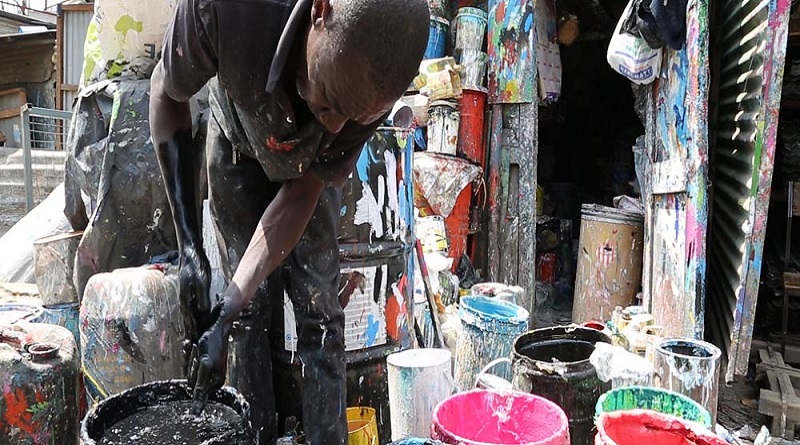Lead, the silent killer, stalks Kenya’s paint industry
Squeezing past the pulley carts stacked high with goods, through the throng of people navigating the sweltering alleyways of Nairobi’s bustling informal industrial sector, Dr Faridah Were can’t hide her unease when she sees a man with half his arm plunged into a large bucket of paint.
Framed by towers of colourful paint buckets in front of his small wooden kiosk, Njuki Mwangi stops hand-mixing his new batch of paint and looks up, smiling.
Dr Were is on a mission. Together with health and medical experts she is helping Kenya to rid its paint industry of lead – the toxin added to paint that is responsible for an estimated 600,000 new cases of intellectual disability among children every year.
She asks Mwangi if he is aware of the dangers that he is exposing himself to. He isn’t. The unregulated informal sector employs three out of four Kenyans, which means the bulk of the labour force is working in environments devoid of the health and safety protections enjoyed in formal employment.
Paints without lead additives have been used in many countries for decades and have proven to be viable, cost-effective alternatives, yet only 36 percent (62 of 196 countries) have legal limits on lead paint. The Global Alliance to Eliminate Lead Paint – led by UN Environment and the World Health Organization – has set the target for all governments to ban lead in paint by 2020.
“All lead in paint must be phased out here in Kenya,†says Dr Were. “We have been working closely with the relevant government agencies to develop national lead standards and we are hopefully on track to meet the 2020 target to ban lead in paint altogether.â€
Milk is not the cure
Further up the lane from Mwangi’s paint shop, tucked around behind residential buildings and next door to three women sitting against a wall chopping up raw chicken, a car spray-painter is busy at work. The fumes from the small yard can be smelled tens of metres away.
Dr Were finds Elijah sanding a used car. Elijah says he knows you can get sick from leaded paint. He says he does wear a mask sometimes, but points across at his workmate, hard at work, spraying another car with no protective gear.
“After you spray you should drink milk,†he says, “because milk helps you to remove the paint dirt from the chest.â€
Unfortunately for Elijah, the Chief Pharmacist at Nairobi’s Kenyatta Hospital, Dr Tom Menge, says the solution for preventing the adverse health effects from exposure to lead is not as simple as drinking a glass of milk after work each day.
“One of challenges we have is [some people] are aware of the toxic effects and have their own ideas on how they can prevent poisoning,†Dr Menge says. “We have a lot people who believe that if they expose themselves to lead in paint and if they drink milk, they will be ok – there is no scientific evidence that milk has got the ability to prevent you from absorbing lead.â€
It is still legal to sell lead paint in many countries around the world for use in industry, decorating homes, schools and children’s toys. As lead paint deteriorates over time, children in particular may inhale or ingest lead through household dust, paint chips or contaminated soil. Childhood lead poisoning can have lifelong health impacts, including learning disabilities, anemia, and disorders in coordination, visual, spatial and language skills.
Dr Menge said it is not just children who are at risk. Lead exposure can affect brain function and fertility in adults, can affect the healthy development of organs in an unborn child and potentially cause miscarriage, and in adult males it can cause infertility.
Although some paint companies in Kenya are now transitioning to manufacturing lead-free paint – namely Basco, Sadolin and Crown Paints – Dr Menge adds that greater support and enforcement by the government is needed, particularly to clean up the informal industry, where exposure can be very high through the use of lead-based paints, solder and batteries.
“It’s a silent killer … it’s not obvious from the symptoms because most of the time it is through chronic lead exposure over a long period of time,†he said.
He adds that is it likely we all have a small amount in our bodies from environmental exposure; however, it is when that exposure becomes concentrated the harmful effects start to come into play.
“It’s high time we started addressing the issue of lead in the informal sector. The cost of treatment is so expensive … the only solution is prevention,†he says.
The international Lead Poisoning Prevention Week is being held October 23-29, 2016




